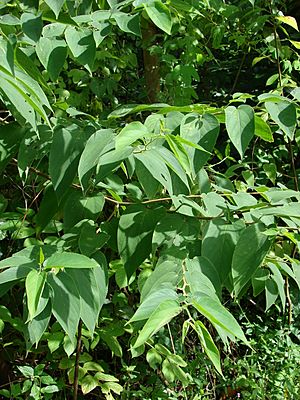Trema orientalis facts for kids
Quick facts for kids Trema orientalis |
|
|---|---|
 |
|
| Conservation status | |
| Scientific classification | |
| Genus: |
Trema
|
| Species: |
orientalis
|
| Synonyms | |
|
|
Trema orientalis is a type of flowering tree. It belongs to the hemp family, called Cannabaceae. This tree has many common names. Some people call it the charcoal-tree or Indian charcoal-tree. Others know it as pigeon wood or Oriental trema. In Hawaii, where it has grown naturally, it is called the gunpowder tree or nalita. You can find this tree in many tropical and warm areas around the world. Its range stretches from South Africa through the Middle East and India. It also grows in southern China, Southeast Asia, and Australia.
Contents
Where Does the Trema Tree Grow?
The Trema orientalis tree is native to many parts of the world. It grows naturally in tropical and southern Africa. This includes the island of Madagascar. It is also found across Asia, including the Arabian Peninsula, China, and eastern Asia. You can see it in tropical Asia and Australia too.
How People Use the Trema Tree
The wood from the Trema orientalis tree is quite soft. It burns easily and quickly once it is dry. This wood is good for making paper and pulp. The paper made from it is strong and can be folded many times without tearing.
The bark of the tree can be used to make string or rope. People also use it to make fishing lines waterproof. In countries like India and Tanzania, the wood is turned into charcoal. It is also known to be a good fire starter.
Medicinal Uses of Trema orientalis
This tree is used in many cultures as an herbal medicine. Different parts of the tree help treat various health issues.
- Leaves and Bark: These parts are used to help with coughs and sore throats. They can also treat asthma, bronchitis, and yellow fever. Some people use them for toothaches. They are also thought to be an antidote for general poisoning.
- Bark Infusion: A drink made from the bark is used to control dysentery.
- Leaf Decoction: A liquid made by boiling the leaves helps to deworm dogs.
Recent studies have looked into the tree's medicinal properties. An extract from the bark has been shown to lower blood sugar levels. This was seen in studies on animals with diabetes mellitus. This suggests it might be helpful for treating this disease in the future. Other trees related to Trema orientalis also show promise. Their leaf extracts have helped with inflammation, arthritis, and pain. This means Trema orientalis might have similar benefits.
Ecological Importance of the Trema Tree
The Trema orientalis tree is very important for its environment. Many different animals and insects rely on it.
- Food for Butterflies: At least 14 types of butterfly use this tree. Their young, called larvae, eat its leaves.
- Food for Birds: Several kinds of birds eat the tree's fruit. They also feed on the many insects that live in these trees.
- Home for Pigeons: Pigeons and doves often visit these trees. They eat the fruits or build their nests there. This is why one of its common names is 'Pigeon Wood'.
- Animal Fodder: The leaves, pods, and seeds are used as fodder for farm animals. This includes cattle, buffaloes, and goats in the Philippines. Wild animals also eat the leaves. People can even eat the leaves like spinach.
This tree grows very quickly. You often find it in areas that have been disturbed. It also grows along the edges of forests. It is a pioneer species, meaning it is one of the first plants to grow in new or damaged areas. It can grow well even in poor soil. This tree helps new forests grow by providing shade and protection. This allows young hardwood trees to grow stronger. T. orientalis also helps improve soil quality. It can perform nitrogen fixation, which adds important nutrients to the soil for other plants.
Gallery
- Pooley, E. (1993). The Complete Field Guide to Trees of Natal, Zululand and Transkei. ISBN: 0-620-17697-0.
- Trema orientalis in West African plants – A Photo Guide.






